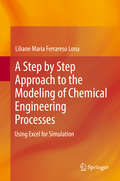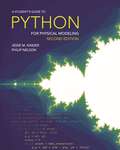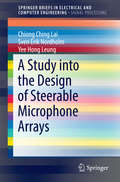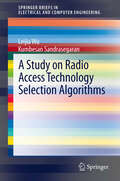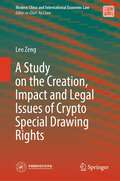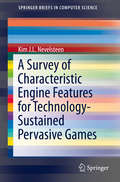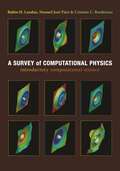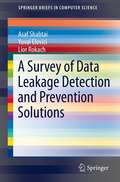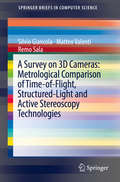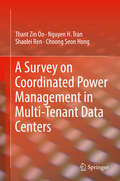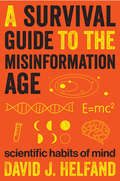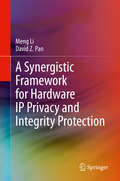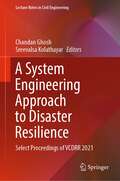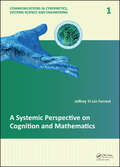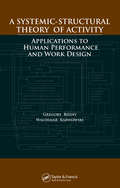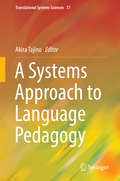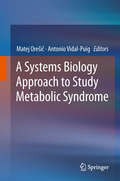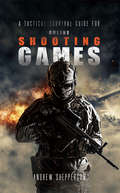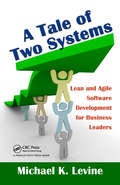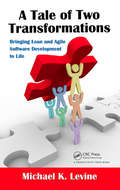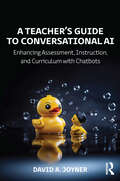- Table View
- List View
A Step by Step Approach to the Modeling of Chemical Engineering Processes
by Liliane Maria Ferrareso LonaThis book treats modeling and simulation in a simple way, that builds on the existing knowledge and intuition of students. They will learn how to build a model and solve it using Excel.Most chemical engineering students feel a shiver down the spine when they see a set of complex mathematical equations generated from the modeling of a chemical engineering system. This is because they usually do not understand how to achieve this mathematical model, or they do not know how to solve the equations system without spending a lot of time and effort.Trying to understand how to generate a set of mathematical equations to represent a physical system (to model) and solve these equations (to simulate) is not a simple task. A model, most of the time, takes into account all phenomena studied during a Chemical Engineering course. In the same way, there is a multitude of numerical methods that can be used to solve the same set of equations generated from the modeling, and many different computational languages can be adopted to implement the numerical methods. As a consequence of this comprehensiveness and combinatorial explosion of possibilities, most books that deal with this subject are very extensive and embracing, making need for a lot of time and effort to go through this subject. It is expected that with this book the chemical engineering student and the future chemical engineer feel motivated to solve different practical problems involving chemical processes, knowing they can do that in an easy and fast way, with no need of expensive software.
A Student's Guide to Coding and Information Theory
by Stefan M. Moser Po-ning ChenThis easy-to-read guide provides a concise introduction to the engineering background of modern communication systems, from mobile phones to data compression and storage. Background mathematics and specific engineering techniques are kept to a minimum so that only a basic knowledge of high-school mathematics is needed to understand the material covered. The authors begin with many practical applications in coding, including the repetition code, the Hamming code and the Huffman code. They then explain the corresponding information theory, from entropy and mutual information to channel capacity and the information transmission theorem. Finally, they provide insights into the connections between coding theory and other fields. Many worked examples are given throughout the book, using practical applications to illustrate theoretical definitions. Exercises are also included, enabling readers to double-check what they have learned and gain glimpses into more advanced topics, making this perfect for anyone who needs a quick introduction to the subject.
A Student's Guide to Python for Physical Modeling: Second Edition
by Jesse M. Kinder Philip NelsonA fully updated tutorial on the basics of the Python programming language for science studentsPython is a computer programming language that has gained popularity throughout the sciences. This fully updated second edition of A Student's Guide to Python for Physical Modeling aims to help you, the student, teach yourself enough of the Python programming language to get started with physical modeling. You will learn how to install an open-source Python programming environment and use it to accomplish many common scientific computing tasks: importing, exporting, and visualizing data; numerical analysis; and simulation. No prior programming experience is assumed.This guide introduces a wide range of useful tools, including:Basic Python programming and scriptingNumerical arraysTwo- and three-dimensional graphicsAnimationMonte Carlo simulationsNumerical methods, including solving ordinary differential equationsImage processingNumerous code samples and exercises—with solutions—illustrate new ideas as they are introduced. This guide also includes supplemental online resources: code samples, data sets, tutorials, and more. This edition includes new material on symbolic calculations with SymPy, an introduction to Python libraries for data science and machine learning (pandas and sklearn), and a primer on Python classes and object-oriented programming. A new appendix also introduces command line tools and version control with Git.
A Study into the Design of Steerable Microphone Arrays (SpringerBriefs in Electrical and Computer Engineering)
by Chiong Ching Lai Sven Erik Nordholm Yee Hong LeungThe book covers the design formulations for broadband beamformer targeting nearfield and farfield sources. The book content includes background information on the acoustic environment, including propagation medium, the array geometries, signal models and basic beamformer designs. Subsequently it introduces design formulation for nearfield, farfield and mixed nearfield-farfield beamformers and extends the design formulation into electronically steerable beamformers. In addition, a robust formulation is introduced for all the designs mentioned.
A Study on Radio Access Technology Selection Algorithms (SpringerBriefs in Electrical and Computer Engineering)
by Leijia Wu Kumbesan SandrasegaranThis book discusses the basic idea of Common Radio Resource Management (CRRM), especially on the Radio Access Technologies selection part of CRRM. It introduces two interaction functions (information reporting function and RRM decision support function) and four interaction degrees (from low to very high) of CRRM. Four possible CRRM topologies (CRRM server, integrated CRRM, Hierarchical CRRM, and CRRM in user terminals) are described. The book presents different Radio Access Technologies selection algorithms, including single criterion and multiple criteria based algorithms are presented and compares them. Finally, the book analyses the advantages and disadvantages of the different selection algorithms.
A Study on the Creation, Impact and Legal Issues of Crypto Special Drawing Rights (Modern China and International Economic Law)
by Leo ZengThis book analyzes the concept, theory, rules, and impact of the reform of the international monetary system and Crypto-SDRs and provides a feasibility analysis of the combination of blockchain technology and SDRs. It explores and summarizes the possibility of solving problems such as the inherent defects of the current international monetary system and creatively suggests that the birth of Crypto-SDR will have a positive impact on countries and industries and fields around the world, especially in anti-money laundering, cross-border asset recovery, international payments, banking, insurance, financial auditing, Fintech regulation, etc.
A Survey of Characteristic Engine Features for Technology-Sustained Pervasive Games (SpringerBriefs in Computer Science)
by Kim J.L. NevelsteenThis book scrutinizes pervasive games from a technological perspective, focusing on the sub-domain of games that satisfy the criteria that they make use of virtual game elements. In the computer game industry, the use of a game engine to build games is common, but current game engines do not support pervasive games. Since the computer game industry is already rich with game engines, this book investigates: (i) if a game engine can be repurposed to stage pervasive games; (ii) if features describing a would-be pervasive game engine can be identified; (iii) using those features, if an architecture be found in the same 'product line' as an existing engine and that can be extended to stage pervasive games (iv) and, finally, if there any challenges and open issues that remain. The approach to answering these questions is twofold. First, a survey of pervasive games is conducted, gathering technical details and distilling a component feature set that enables pervasive games. Second, a type of game engine is chosen as candidate in the same product line as a would-be pervasive game engine, supporting as much of the feature set as possible. The architecture is extended to support the entire feature set and used to stage a pervasive game called Codename: Heroes, validating the architecture, highlighting features of particular importance and identifying any open issues. The conclusion of this book is also twofold: the resulting feature set is verified to coincide with the definition of pervasive games and related work. And secondly, a virtual world engine is selected as candidate in the same product line as a would-be pervasive game engine. Codename: Heroes was successfully implemented, reaping the benefits of using the selected engine; development time was low, spanning just a few months. Codename: Heroes was staged twice, with no stability issues or down time.
A Survey of Computational Physics: Introductory Computational Science
by Cristian C. Bordeianu José Páez Rubin LandauComputational physics is a rapidly growing subfield of computational science, in large part because computers can solve previously intractable problems or simulate natural processes that do not have analytic solutions. The next step beyond Landau's First Course in Scientific Computing and a follow-up to Landau and Páez's Computational Physics, this text presents a broad survey of key topics in computational physics for advanced undergraduates and beginning graduate students, including new discussions of visualization tools, wavelet analysis, molecular dynamics, and computational fluid dynamics. By treating science, applied mathematics, and computer science together, the book reveals how this knowledge base can be applied to a wider range of real-world problems than computational physics texts normally address. Designed for a one- or two-semester course, A Survey of Computational Physics will also interest anyone who wants a reference on or practical experience in the basics of computational physics. Accessible to advanced undergraduates Real-world problem-solving approach Java codes and applets integrated with text Companion Web site includes videos of lectures
A Survey of Core Research in Information Systems (SpringerBriefs in Computer Science)
by Anna Sidorova Nicholas Evangelopoulos Russell Torres Vess JohnsonThe Information Systems (IS) discipline was founded on the intersection of computer science and organizational sciences, and produced a rich body of research on topics ranging from database design and the strategic role of IT to website design and online consumer behavior. In this book, the authors provide an introduction to the discipline, its development, and the structure of IS research, at a level that is appropriate for emerging and current IS scholars. Guided by a bibliometric study of all research articles published in eight premier IS research journals over a 20-year period, the authors identify and present the top 51 IS research topics. For each topic, they provide a brief overview, time trends, and references to related influential research works. The topics are organized into an IS research framework that includes research on the IT artifact and IS development, IT and organizations, IT and individuals, IT and markets, and IT for teamwork and collaboration.
A Survey of Data Leakage Detection and Prevention Solutions (SpringerBriefs in Computer Science)
by Yuval Elovici Asaf Shabtai Lior RokachSpringerBriefs present concise summaries of cutting-edge research and practical applications across a wide spectrum of fields. Featuring compact volumes of 50 to 100 pages (approximately 20,000- 40,000 words), the series covers a range of content from professional to academic. Briefs allow authors to present their ideas and readers to absorb them with minimal time investment. As part of Springer's eBook collection, SpringBriefs are published to millions of users worldwide. Information/Data Leakage poses a serious threat to companies and organizations, as the number of leakage incidents and the cost they inflict continues to increase. Whether caused by malicious intent, or an inadvertent mistake, data loss can diminish a company's brand, reduce shareholder value, and damage the company's goodwill and reputation. This book aims to provide a structural and comprehensive overview of the practical solutions and current research in the DLP domain. This is the first comprehensive book that is dedicated entirely to the field of data leakage and covers all important challenges and techniques to mitigate them. Its informative, factual pages will provide researchers, students and practitioners in the industry with a comprehensive, yet concise and convenient reference source to this fascinating field. We have grouped existing solutions into different categories based on a described taxonomy. The presented taxonomy characterizes DLP solutions according to various aspects such as: leakage source, data state, leakage channel, deployment scheme, preventive/detective approaches, and the action upon leakage. In the commercial part we review solutions of the leading DLP market players based on professional research reports and material obtained from the websites of the vendors. In the academic part we cluster the academic work according to the nature of the leakage and protection into various categories. Finally, we describe main data leakage scenarios and present for each scenario the most relevant and applicable solution or approach that will mitigate and reduce the likelihood and/or impact of the leakage scenario.
A Survey of Fractal Dimensions of Networks (SpringerBriefs in Computer Science)
by Eric RosenbergMany different fractal dimensions have been proposed for networks. In A Survey of Fractal Dimensions of Networks the theory and computation of the most important of these dimensions are reviewed, including the box counting dimension, the correlation dimension, the mass dimension, the transfinite fractal dimension, the information dimension, the generalized dimensions (which provide a way to describe multifractals), and the sandbox method (for approximating the generalized dimensions). The book describes the use of diameter-based and radius-based boxes, and presents several heuristic methods for box counting, including greedy coloring, random sequential node burning, and a method for computing a lower bound. We also discuss very recent results on resolving ambiguity in the calculation of the information dimension and the generalized dimensions, and on the non-monotonicity of the generalized dimensions. Anyone interested in the theory and application of networks will want to read this Brief. This includes anyone studying, e.g., social networks, telecommunications networks, transportation networks, ecological networks, food chain networks, network models of the brain, or financial networks.
A Survey on 3D Cameras: Metrological Comparison of Time-of-Flight, Structured-Light and Active Stereoscopy Technologies (SpringerBriefs in Computer Science)
by Silvio Giancola Matteo Valenti Remo SalaThis book is a valuable resource to deeply understand the technology used in 3D cameras. In this book, the authors summarize and compare the specifications of the main 3D cameras available in the mass market. The authors present a deep metrological analysis of the main camera based on the three main technologies: Time-of-Flight, Structured-Light and Active Stereoscopy, and provide qualitative results for any user to understand the underlying technology within 3D camera, as well as practical guidance on how to get the most of them for a given application.
A Survey on Coordinated Power Management in Multi-Tenant Data Centers
by Thant Zin Oo Nguyen H. Tran Shaolei Ren Choong Seon HongThis book investigates the coordinated power management of multi-tenant data centers that account for a large portion of the data center industry. The authors include discussion of their quick growth and their electricity consumption, which has huge economic and environmental impacts. This book covers the various coordinated management solutions in the existing literature focusing on efficiency, sustainability, and demand response aspects. First, the authors provide a background on the multi-tenant data center covering the stake holders, components, power infrastructure, and energy usage. Then, each power management mechanism is described in terms of motivation, problem formulation, challenges and solution.
A Survival Guide to the Misinformation Age: Scientific Habits of Mind
by David J. HelfandLearning how to tell news from fake news from fake fake news: An &“important and timely&” book on protecting ourselves, and society, from the infodemic (Library Journal). We have billions of bytes of data at our fingertips. But how much of it is misinformation—or even disinformation? A lot of it is, and your search engine can&’t tell the difference. As a result, an avalanche of misinformation threatens to overwhelm the discourse we so desperately need to address complex social problems such as climate change, the food and water crises, biodiversity collapse, and emerging threats to public health. This book provides an inoculation against the misinformation epidemic by cultivating scientific habits of mind. Anyone can do it—indeed, everyone must do it if our species is to survive on this crowded and finite planet. This survival guide supplies an essential set of apps for the prefrontal cortex while making science both accessible and entertaining. It will dissolve your fear of numbers, demystify graphs, and elucidate the key concepts of probability, all while celebrating the precise use of language and logic. David Helfand, one of our nation&’s leading astronomers and science educators, has taught scientific habits of mind to generations in the classroom, where he continues to wage a provocative battle against sloppy thinking and the encroachment of misinformation. &“Provides a vital antidote to the ills of misinformation by teaching systematic and rigorous scientific reasoning.&” —The Times Literary Supplement
A Synergistic Framework for Hardware IP Privacy and Integrity Protection
by Meng Li David Z. PanThis book proposes a synergistic framework to help IP vendors to protect hardware IP privacy and integrity from design, optimization, and evaluation perspectives. The proposed framework consists of five interacting components that directly target at the primary IP violations. All the five algorithms are developed based on rigorous mathematical modeling for primary IP violations and focus on different stages of IC design, which can be combined to provide a formal security guarantee.
A System Engineering Approach to Disaster Resilience: Select Proceedings of VCDRR 2021 (Lecture Notes in Civil Engineering #205)
by Sreevalsa Kolathayar Chandan GhoshThis book presents the select proceedings of the Virtual Conference on Disaster Risk Reduction (VCDRR 2021). It emphasizes on the role of civil engineering for a disaster resilient society. Various topics covered in this book are risk assessment, prevention, mitigation, preparedness and response, early warning system, hazard mapping, engineering innovations for hazard mitigation, and safe design of structures. This book is a comprehensive volume on disaster risk reduction (DRR) and its management for a sustainable built environment. This book will be useful for the students, researchers, policy makers and professionals working in the area of civil engineering, especially disaster management.
A Systematic Approach to Learning Robot Programming with ROS
by Wyatt Newman<p>A Systematic Approach to Learning Robot Programming with ROS provides a comprehensive, introduction to the essential components of ROS through detailed explanations of simple code examples along with the corresponding theory of operation. The book explores the organization of ROS, how to understand ROS packages, how to use ROS tools, how to incorporate existing ROS packages into new applications, and how to develop new packages for robotics and automation. It also facilitates continuing education by preparing the reader to better understand the existing on-line documentation. <p>The book is organized into six parts. It begins with an introduction to ROS foundations, including writing ROS nodes and ROS tools. Messages, Classes, and Servers are also covered. The second part of the book features simulation and visualization with ROS, including coordinate transforms. <p>The next part of the book discusses perceptual processing in ROS. It includes coverage of using cameras in ROS, depth imaging and point clouds, and point cloud processing. Mobile robot control and navigation in ROS is featured in the fourth part of the book <p>The fifth section of the book contains coverage of robot arms in ROS. This section explores robot arm kinematics, arm motion planning, arm control with the Baxter Simulator, and an object-grabber package. The last part of the book focuses on system integration and higher-level control, including perception-based and mobile manipulation. <p>This accessible text includes examples throughout and C++ code examples are also provided at https://github.com/wsnewman/learning_ros</p>
A Systemic Perspective on Cognition and Mathematics (Communications in Cybernetics, Systems Science and Engineering)
by Jeffrey Yi-Lin ForrestThis book is devoted to the study of human thought, its systemic structure, and the historical development of mathematics both as a product of thought and as a fascinating case analysis. After demonstrating that systems research constitutes the second dimension of modern science, the monograph discusses the yoyo model, a recent ground-breaking deve
A Systemic-Structural Theory of Activity: Applications to Human Performance and Work Design
by Waldemar Karwowski Gregory BednyWhile its importance is widely recognized, the theoretical basis and practical applications of Activity Theory have not yet been firmly established in the field of human factors and ergonomics, experimental, and work psychology. This book presents the foundations of the systemic-structural theory of human activity. It contains multiple practical examples of systemic-structural theory of activity analyses, including a study of production operations in the manufacturing environment, system safety evaluation, work improvement, equipment design, robot system performance, and design of human/computer interaction tasks in the context of training, efficiency, work motivation, fatigue, personality, and individual style of performance.
A Systems Approach to Language Pedagogy (Translational Systems Sciences #17)
by Akira TajinoThis volume represents the first attempt in the field of language pedagogy to apply a systems approach to issues in English language education. In the literature of language education, or more specifically, second or foreign language learning and teaching, each topic or issue has often been dealt with independently, and been treated as an isolated item. Taking grammar instruction as an example, grammatical items are often taught in a sequential, step-by-step manner; there has been no “road map” in which the interrelations between the various items are demonstrated. This may be one factor that makes it more difficult for students to learn the language organically. The topics covered in this volume, including language acquisition, pedagogical grammar, and teacher collaboration, are viewed from a holistic perspective. In other words, language pedagogy is approached as a dynamic system of interrelations. In this way, “emergent properties” are expected to manifest. This book is recommended for anyone involved in language pedagogy, including researchers, teachers, and teacher trainers, as well as learners.
A Systems Biology Approach to Study Metabolic Syndrome
by Matej Orešič Antonio Vidal-PuigThe aim of this book is to provide the target audience, specifically students of Medicine, Biology, Systems Biology and Bioinformatics, as well as experienced researchers in research fields relevant to metabolic syndrome (MetS) with an overview of the challenges and opportunities in systems biology and how it can be used to tackle MetS. In particular, the aims are: (1) to provide an introduction to the key biological processes involved in the pathophysiology of MetS; (2) through the use of specific examples, provide an introduction to the latest technologies that use a systems biology approach to study MetS; and (3) to give an overview of the mathematical modeling approaches for studying MetS. The clearly written chapters by leading experts in the field provides detailed descriptions crucial for the unique position of this book and its focus on the application of systems biology to tackle specific pathophysiologically relevant aspects of MetS and provides a valuable practical guide to this research community.
A Tactical Survival Guide For Online Shooting Games
by Andrew SheppersonThis book has been written as a guide to help anyone struggling with online multiplayer First-Person Shooter (FPS) games or even if you just want to sharpen up your existing skills. By reading through the strategies, you should easily improve your game, and become a more formidable opponent. This book covers any potential problems you may encounter during FPS online play and incorporates generic techniques that you will be able to use in all FPS games regardless of their origin, timescale, control system or platform. The things that remain the same in all FPS are the basic tactics and techniques that are employed by some of the worlds best online gamers and some of the world's most formidable military powers. These are the superior tactics that you will be able to utilise in any FPS game you play and will keep you one step ahead of any player.
A Tale of Two Systems: Lean and Agile Software Development for Business Leaders
by Michael K. LevineThis business parable reviews two different systems development projects. One project was an abject, expensive failure, while the other succeeded in creating a major new revenue stream, bringing in new customers. By reviewing the tales of these two systems, readers will develop a better understanding of what works and what doesn‘t when it comes to
A Tale of Two Transformations: Bringing Lean and Agile Software Development to Life
by Michael K. LevineThere are many books that seek to explain Lean and Agile software that offer theory, techniques, and examples. Michael Levine’s first book, A Tale of Two Systems, is one of the best, synthesizing Lean manufacturing and product development with agile software concepts in an engaging business novel. However, there has been precious little practical guidance for those seeking to change existing organizations to become Lean and Agile, until now. Mr. Levine has followed the successful approach of A Tale of Two Systems, telling two simultaneous intertwined and contrasting stories, to bring organizational transformation to life. Mary O’Connell and James "Wes" Wesleyan, recently engaged to be married, share a commitment to Lean and Agile Software. They have recently become leaders in two very different companies – one, stuck in a slow-moving, unresponsive, process-driven quagmire of a software culture; the other, struggling through the chaos of a sales-driven, process-less swirl. Together with their wise mentor, Neville Roberts, they identify two approaches to making needed changes: Drive People (a top-down approach focused on processes and tools), and People Driven (an enablement approach focused on people and organizations). Mary and Wes evaluate their situations and choose approaches that best fit for them, and the transformations commence. A Tale of Two Transformations differs from many information technology books by grappling with all the complexities of our organizations: the people, the politics, the financials, the processes – in short, the culture from which our Lean and Agile journeys must begin. The change model presented in the flow of the stories is generally applicable, and can help anyone thinking about how to improve their organization.
A Teacher’s Guide to Conversational AI: Enhancing Assessment, Instruction, and Curriculum with Chatbots
by David A. JoynerA Teacher’s Guide to Conversational AI explores the practical role that language-based artificial intelligence tools play in classroom teaching, learning experiences, and student assessment. Today’s educators are well aware that conversational and generative AI—chatbots, intelligent tutoring systems, large language models, and more—represent a complex new factor in teaching and learning. This introductory primer offers comprehensive, novice-friendly guidance into the challenges and opportunities of incorporating AI into K-12 schools and college classes in ways that are appropriate, nourishing to students, and outcomes-driven.Opening with an informative overview of the foundational properties, key terminology, and ethical considerations of these tools, the book offers a coherent and realistic vision of classrooms that are enhanced, rather than stymied, by AI systems. This includes strategies for:· designing assessments that are conducive to students’ beneficial use of AI while mitigating overreliance or dishonesty;· using AI to generate lesson examples for student critique or custom content that reinforces course principles;· leveraging chatbots as a co-instructor or a tutor, a guide during student-driven learning, a virtual debate or brainstorming partner, and a design project; and· creating course content, lesson plans and activities, expanded language and accessibility options, and beyond. Through the depth of understanding and applied approach provided in these chapters, teachers and leaders in training and in service, alongside private tutors, college instructors, and other educators, will be better prepared to future-proof their efforts to serve new generations of learners.
